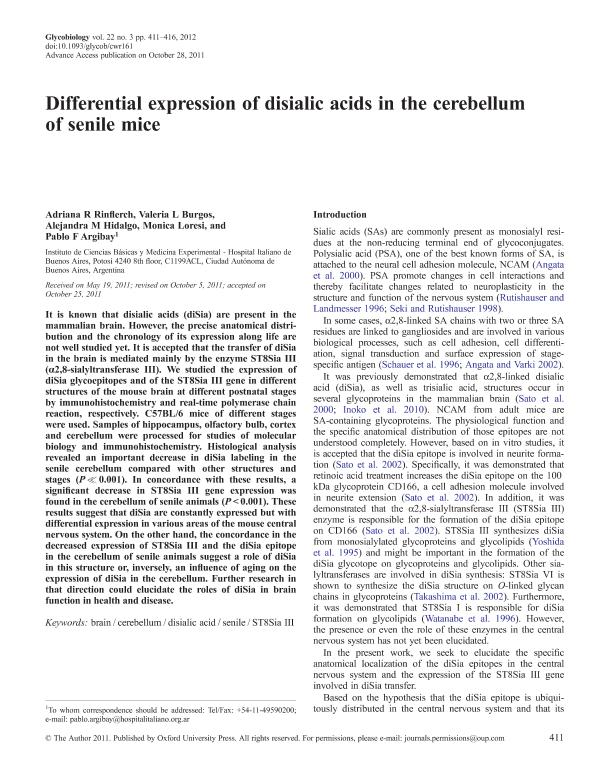Artículo
Differential expression of disialic acids in the cerebellum of senile mice
Rinflerch, Adriana Raquel ; Burgos, Valeria Laura
; Burgos, Valeria Laura ; Hidalgo, Alejandra Mabel; Loresi, Monica Alejandra; Argibay, Pablo F.
; Hidalgo, Alejandra Mabel; Loresi, Monica Alejandra; Argibay, Pablo F.
 ; Burgos, Valeria Laura
; Burgos, Valeria Laura ; Hidalgo, Alejandra Mabel; Loresi, Monica Alejandra; Argibay, Pablo F.
; Hidalgo, Alejandra Mabel; Loresi, Monica Alejandra; Argibay, Pablo F.
Fecha de publicación:
03/2012
Editorial:
Oxford Univ Press Inc
Revista:
Glycobiology
ISSN:
0959-6658
Idioma:
Inglés
Tipo de recurso:
Artículo publicado
Clasificación temática:
Resumen
It is known that disialic acids (diSia) are present in the mammalian brain. However, the precise anatomical distribution and the chronology of its expression along life are not well studied yet. It is accepted that the transfer of diSia in the brain is mediated mainly by the enzyme ST8Sia III (α2,8-sialyltransferase III). We studied the expression of diSia glycoepitopes and of the ST8Sia III gene in different structures of the mouse brain at different postnatal stages by immunohistochemistry and real-time polymerase chain reaction, respectively. C57BL/6 mice of different stages were used. Samples of hippocampus, olfactory bulb, cortex and cerebellum were processed for studies of molecular biology and immunohistochemistry. Histological analysis revealed an important decrease in diSia labeling in the senile cerebellum compared with other structures and stages (P ≪ 0.001). In concordance with these results, a significant decrease in ST8Sia III gene expression was found in the cerebellum of senile animals (P < 0.001). These results suggest that diSia are constantly expressed but with differential expression in various areas of the mouse central nervous system. On the other hand, the concordance in the decreased expression of ST8Sia III and the diSia epitope in the cerebellum of senile animals suggest a role of diSia in this structure or, inversely, an influence of aging on the expression of diSia in the cerebellum. Further research in that direction could elucidate the roles of diSia in brain function in health and disease.
Palabras clave:
BRAIN
,
CEREBELLUM
,
DISIALIC ACID
,
SENILE
,
ST8SIA III
Archivos asociados
Licencia
Identificadores
Colecciones
Articulos(SEDE CENTRAL)
Articulos de SEDE CENTRAL
Articulos de SEDE CENTRAL
Citación
Rinflerch, Adriana Raquel; Burgos, Valeria Laura; Hidalgo, Alejandra Mabel; Loresi, Monica Alejandra; Argibay, Pablo F.; Differential expression of disialic acids in the cerebellum of senile mice; Oxford Univ Press Inc; Glycobiology; 22; 3; 3-2012; 411-416
Compartir
Altmétricas



